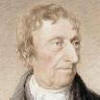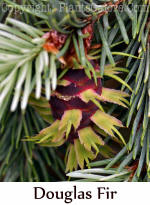Comments
from Mr. PGC: Throughout
history, many people have made lasting contributions to the
world of plants. In these pages, we hope to pay tribute to
some of them. Our concentration will be primarily on those
who have introduced plants to the gardening world, those who
have helped spread the word about gardening and those who
have made significant contributions to landscaping and
landscaping design around the world.
This list will be constantly growing as we add
new names. If you have someone who you think should be on
the list, please send us an
Email.
|
|
 |
 |
|
|
 |
|
James Dickson |
|
 |
|
 |
Dahl was a
Swedish botanist and a
student of pioneering taxonomist
Carolus Linnaeus.
After studying at the
Uppsala University
and the University of Kiel,
Germany,
he taught medicine and botany at the University of Helsinki,
Finland. Dahl was a renowned botanist and publisher of Observationes
botanicæ circa Systema vegetabilium divi a Linné.
The genus,
Dahlia,
is named after him
although it is not clear exactly who made that choice.

|
|
 |
|
 |
 French Father David, was sent to
China
as a missionary.
He was a man of wide interests beyond his religion including botany, zoology, geology and ornithology. French Father David, was sent to
China
as a missionary.
He was a man of wide interests beyond his religion including botany, zoology, geology and ornithology.
While attending to his priestly duties, he also had time to
collect and record about 250 new
plant species including
Davidia involucrata,
Rodgersia
aesculifolia,
Photonia davidiana,
Acer
davidii,
Rosa davidii,
Astilbe chinensis var.
davidii,
Buddleja davidii, Chrysosplenum davidianum,
Clematis armandii,
Lilium davidii,
Pinus armandii,
Populus tremuloides var. davidiana.

|
|
 |
|
 |
 From
Seattle, Washington, Mr. Davidson was an author, gardener and
botanist. His books include Lewisias and Portfolio:
Oregon Iris Trek. Plants named in his honor include
Pulmonaria 'Roy Davidson'. From
Seattle, Washington, Mr. Davidson was an author, gardener and
botanist. His books include Lewisias and Portfolio:
Oregon Iris Trek. Plants named in his honor include
Pulmonaria 'Roy Davidson'.
*Email comment from David: "Penstemon
davidsonii was named in 1892 for George Davidson (1825-1911),
not for B. Leroy Davidson."
|
 |
|
 |
 The first European botanist in
Western China. He discovered many
garden plants in Yunnan among the 1,500 species he is said to have
discovered. He was the first to record the blue poppy,
Meconopsis betonicifolia. A magnolia (Magnolia delavayi) and silver fir
(Abies delavayi) bear his name. The first European botanist in
Western China. He discovered many
garden plants in Yunnan among the 1,500 species he is said to have
discovered. He was the first to record the blue poppy,
Meconopsis betonicifolia. A magnolia (Magnolia delavayi) and silver fir
(Abies delavayi) bear his name.
Other plants that bear his name are
Thalictrum delavayi,
Paeonia delavayi and
Incarvillea delavayi.

|
|
 |
|
 |
The genus,
Deutzia (Beautybush) is named for this alderman of
Amsterdam, the
Netherlands. His friend, the plant explorer,
Carl Pehr
Thunberg found the plant and named it in honor of his
friend, van der Deutz.
|
 |
|
 |
 British
nurseryman and botanist for whom the genus, Dicksonia,
was named. British
nurseryman and botanist for whom the genus, Dicksonia,
was named.

|
 |
|
 |
 A
German
physician, Dieffenbach was also a geologist and
naturalist.
He was one of the first to explore much of
New Zealand and
published a book titled,
Travels in
New Zealand in 1843. The genus, Dieffenbachia
(Dumbcane), was named for him. A
German
physician, Dieffenbach was also a geologist and
naturalist.
He was one of the first to explore much of
New Zealand and
published a book titled,
Travels in
New Zealand in 1843. The genus, Dieffenbachia
(Dumbcane), was named for him.

|
 |
|
 |
 Irish
plantswoman and garden writer known for her
garden in Dublin. She has lectured and collected plants
in several countries and is a regular on gardening
television and in the news papers. Her books include
Garden Artistry and Helen
Dillon on Gardening. Irish
plantswoman and garden writer known for her
garden in Dublin. She has lectured and collected plants
in several countries and is a regular on gardening
television and in the news papers. Her books include
Garden Artistry and Helen
Dillon on Gardening.
Plants named
in her honor include
Heuchera 'Helen Dillion' and
Scabiosa 'Helen Dillon'.

|
|
 |
|
 |
Pedanius Dioscorides was a Greek physician,
pharmacologist, botanist, and author of De Materia Medica
which was a 5-volume encyclopedia about herbal
medicine and related medicinal substances, that was widely
read for more than 1,500 years.

|
 |
|
 |
  Michael
A. Dirr is a professor of horticulture at the University of
Georgia. He is the author of eleven books, including Dirr's
Hardy Trees and Shrubs and the Manual of Woody Landscape
Plants which is considered by many to be the "bible" of
landscape trees and shrubs. It is used as the text book for
plant identification courses at many major universities. Michael
A. Dirr is a professor of horticulture at the University of
Georgia. He is the author of eleven books, including Dirr's
Hardy Trees and Shrubs and the Manual of Woody Landscape
Plants which is considered by many to be the "bible" of
landscape trees and shrubs. It is used as the text book for
plant identification courses at many major universities.

|
 |
|
 |
 David
Douglas from the village of
Scone
in
Scotland was
one of the best known plant explorers of the early to mid 19th
century. His explorations of the
North American continent along
with others such as Pennsylvanian,
John Bartram,
the Swedish botanist,
Peter Kalm and Englishman,
Thomas Nuttall opened that part
of the world to European gardeners. David
Douglas from the village of
Scone
in
Scotland was
one of the best known plant explorers of the early to mid 19th
century. His explorations of the
North American continent along
with others such as Pennsylvanian,
John Bartram,
the Swedish botanist,
Peter Kalm and Englishman,
Thomas Nuttall opened that part
of the world to European gardeners.

In his youth, Douglas moved to Glasgow and became associated
with the renowned Professor of Botany,
William James Hooker of Glasgow University and later, the
Royal Botanic Garden at Kew. Through this connection,
Douglas became a plant collector for the
Royal
Horticultural Society
(then the Horticultural Society of London) who sponsored
his trips to America.
Douglas
was known for his adventurous manner which, ironically,
eventually led to his death in
Hawaii. Perhaps tops on his list
of discoveries was the tree that bears his name, the Douglas Fir
(Pseudotsuga
menziesii) which he found in the Cascade Mountain range
of the Western part of
North America. He named the plant for its
resemblance to hemlock (which is in the genus,
Tsuga, therefore Pseudtsuga) and for fellow
Scottish explorer,
Archibald Menzies. Menzies was actually the first to
describe the species but Douglas was first to send seeds back to
England.
 During
his career as a plant explorer, he made three trips to North
America where he visited both the east and west coast. However,
he seemed to be most attracted to the Northwest Territory and
its mountainous regions. He was sponsored by various individuals
and organizations and sent both live plants and preserved
specimens back to London. During
his career as a plant explorer, he made three trips to North
America where he visited both the east and west coast. However,
he seemed to be most attracted to the Northwest Territory and
its mountainous regions. He was sponsored by various individuals
and organizations and sent both live plants and preserved
specimens back to London.
 In 1834 after having a falling out with the
Royal Horticultural
Society and losing his funding, Douglas left North America but
first made his way to the Hawaiian Islands. He spent several
months exploring for plants there but, at least according to
reports, he stumbled into a deep pit which was constructed to
capture wild cattle on the island. They discovered his mangled,
dead body and concluded that a wild bull also in the pit must
have gorged him to death. Some people theorize that he was murdered but
this was never proven. In 1834 after having a falling out with the
Royal Horticultural
Society and losing his funding, Douglas left North America but
first made his way to the Hawaiian Islands. He spent several
months exploring for plants there but, at least according to
reports, he stumbled into a deep pit which was constructed to
capture wild cattle on the island. They discovered his mangled,
dead body and concluded that a wild bull also in the pit must
have gorged him to death. Some people theorize that he was murdered but
this was never proven.
Of course, local peoples were already familiar with their native plants, but Douglas "discovered" many species meaning that
he found specimens unknown in
Europe and sent them back to his
sponsors. Among the more
well-known plants he introduced include Oregon grape holly (Mahonia
aquifolium), Western hemlock (Tsuga heterophylla),
Balsam Fir (Abies
balsamea),
Yellow Fritillary or
Mission Bell (Fritillaria pudica),
Western White Pine (Pinus monticola), Ponderosa
Pine (Pinus ponderosa),
and the Sitka Spruce
(Picea
sitchensis).
Plants including
Iris douglasiana,
Limnanthes
douglasii,
Allium douglasii,
Phlox douglasii, Douglasia nivalis (mountain
pink),
Acer glabrum var. douglasii (Douglas’s
maple),
Cicuta douglasii (water-hemlock),
Juniperus horizontalis 'Douglasii' and
Polygonum douglasii (Douglas’s knot-weed) are named for him.

|
 |
|
 |
 Downing is considered the founder of landscape gardening in the
United States. While Olmstead
worked with the grander landscapes on a larger
scale, Downing dealt more with the home gardens of the American middle-class.
His landscapes were influenced
by the English trends at the time and were meant to be more "natural" in appearance. He wrote his influential book,
The Theory and Practice of Landscape Gardening,
in 1849.

|
 |
|
 |
 English pharmacist who
was Mayor of Oxford,
England in 1900. He collected about 200,000
plant specimens from the
British Isles for the
Oxford
University Herbarium. English pharmacist who
was Mayor of Oxford,
England in 1900. He collected about 200,000
plant specimens from the
British Isles for the
Oxford
University Herbarium.
The
species,
Geranium x oxonianum ‘Claridge Druce’
is named for him.

|
|
 |
|
 |
Born in
Scotland, Drummond worked as the curator of the Botanic
Garden at Cork,
Ireland. In 1829, he was appointed to
develop a botanic garden in Western
Australia. During
his time in
Australia, he explored the continent for plants
to send back to
England.
He is credited
with introducing several plant species including
Chorizema varium, Pimelia spectabilis and
Leschenaultia biloba.
The species,
Acacia drummondi was named after him and the genus
Drummondita for both him and his brother Thomas
Drummond.

|
 |
|
 |
 French architect who specialized in restoration of
classical French gardens such as the châteaux of Vaux-le-Vicomte,
Courances and Corbeil Cerf in
France and Schlosspark Nordkirchen
in Germany. He was associated with the pools and Mermaid Fountain at
Blenheim Palace
in Oxfordshire,
England.

|
|

